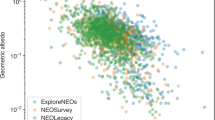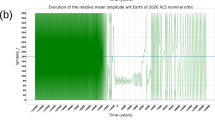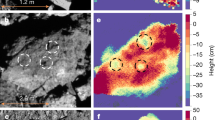Abstract
Near-Earth asteroids are small (diameters < 10 km), rocky bodies with orbits that approach that of the Earth (they come within 1.3 AU of the Sun). Most have a chance of approximately 0.5% of colliding with the Earth in the next million years. The total number of such bodies with diameters > 1 km has been estimated to be in the range 1,000–2,000, which translates to an approximately 1% chance of a catastrophic collision with the Earth in the next millennium1,2. These numbers are, however, poorly constrained because of the limitations of previous searches using photographic plates. (One kilometre is below the size of a body whose impact on the Earth would produce global effects3.) Here we report an analysis of our survey for near-Earth asteroids that uses improved detection technologies. We find that the total number of asteroids with diameters > 1 km is about half the earlier estimates. At the current rate of discovery of near-Earth asteroids, 90% will probably have been detected within the next 20 years.
This is a preview of subscription content, access via your institution
Access options
Subscribe to this journal
Receive 51 print issues and online access
$199.00 per year
only $3.90 per issue
Buy this article
- Purchase on Springer Link
- Instant access to full article PDF
Prices may be subject to local taxes which are calculated during checkout

Similar content being viewed by others
References
Shoemaker, E. M., Wolfe, R. F. & Shoemaker, C. S. in Global Catastrophes in Earth History (eds Sharpton, V. L & Ward, P. D) 155–170 (Geological Society of America, Boulder, Colorado, 1990).
Rabinowitz, D. L., Bowell, E., Shoemaker, E. M. & Muinonen, K. in Hazards due to Comets and Asteroids (ed. Gehrels, T.) 285– 312 (Univ. Arizona Press, Tucson, 1994).
The Threat and the Opportunity of Asteroid and other Near-Earth Objects: Hearing before the Subcommittee on Space and Aeronautics of the Committee on Science (US House of Representatives) (US Government Printing Office, Washington DC, 1998).
Pravdo, S. H. et al. The near-Earth asteroid tracking (NEAT) program: an automated system for telescope control, wide-field imaging, and object detection. Astron. J. 117, 1616–1633 (1999).
Gehrels, T. Scanning with charge-coupled devices. Space Sci. Rev. 58, 347–375 (1991).
Helin, E. F. & Dunbar, R. S. Search techniques for near-Earth asteroids. Vistas Astron. 33, 21– 37 (1990).
Helin, E. F. & Shoemaker, E. M. The Palomar planet-crossing asteroid survey, 1973–1978. Icarus 40, 321–328 (1979).
Harris, A. W. in Collisional Processes in the Solar System (eds Rickman, H. & Marov, M. ) (Kluwer, Dordrecht, in the press).
Rabinowitz, D. L. The size distribution of the Earth-approaching asteroids. Astrophys. J. 407, 412–427 ( 1993).
Rabinowitz, D. L. The size and shape of the near-Earth asteroid belt. Icarus 111, 364–377 (1994).
Marsden, B. G. Electronic Listing at the Minor Planet Center of the IAU (cited July '99) 〈http://cfa-www. harvard. edu/iau/NEO/TheNEOPage. html〉.
Bowell, E. & Muinonen, K. in Hazards due to Comets and Asteroids (ed. Gehrels, T. ) 149–197 (Univ. Arizona Press, Tucson, 1994).
McFadden, L-A., Tholen, D. J. & Veeder, G. J. in Asteroids II (eds Binzel, R. P, Gehrels, T. & Matthews, M. S.) 442–467 (Univ. Arizona Press, Tucson, 1989).
Bowell, E. et al. in Asteroids II (eds Binzel, R. P, Gehrels, T. & Matthews, M. S.) 524–556 (Univ. Arizona Press, Tucson, 1989).
Acknowledgements
The research described in this paper was carried out by the Jet Propulsion Laboratory, California Institute of Technology, under a contract with the National Aeronautics and Space Administration.
Author information
Authors and Affiliations
Rights and permissions
About this article
Cite this article
Rabinowitz, D., Helin, E., Lawrence, K. et al. A reduced estimate of the number of kilometre-sized near-Earth asteroids . Nature 403, 165–166 (2000). https://doi.org/10.1038/35003128
Received:
Accepted:
Issue Date:
DOI: https://doi.org/10.1038/35003128
This article is cited by
-
Near-Earth object hazardous impact: A Multi-Criteria Decision Making approach
Scientific Reports (2016)
-
Electric Solar Wind Sail Kinetic Energy Impactor for Asteroid Deflection Missions
The Journal of the Astronautical Sciences (2016)
-
A 500-kiloton airburst over Chelyabinsk and an enhanced hazard from small impactors
Nature (2013)
-
Dynamics and Coastal Effects of Tsunamis Generated by Asteroids Impacting the Black Sea
Pure and Applied Geophysics (2011)
-
Risks for poisoning of coastal and inland population due to asteroid impacts in Southern regions of Black Sea
Stochastic Environmental Research and Risk Assessment (2008)
Comments
By submitting a comment you agree to abide by our Terms and Community Guidelines. If you find something abusive or that does not comply with our terms or guidelines please flag it as inappropriate.



